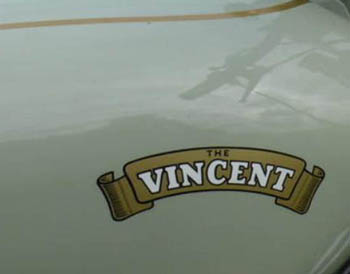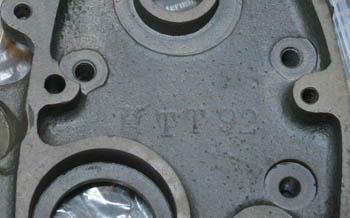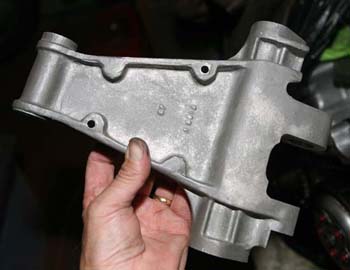
Collecting Parts for a New Vincent Project - Vincent Grey Flash (Rep)
Recent Finds
I nearly titled this article 'There are Hard To Find Parts and then there is Rocking Horse Manure’, but was afraid it would sound too much like I was gloating!
But the truth is, a couple of weeks after having taken the photographs you see here, I still have that warm feeling inside that only comes along once every 5 or 10 years (if you are lucky) - when you know you have just been very fortunate and managed to find something really very rare and difficult to find, and the parts shown here definitely fall into that category.
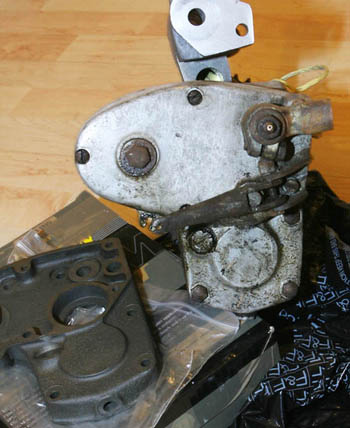
Albion Model H Type 5 racing gearbox - sat on my kitchen floor
As can be seen, condition looks generally very good, although the outer cover casting has lost its lug that holds the clutch operating arm - a steel fabrication has been made up to replace. This should not be a problem to weld back on
Albion Model H Gearbox
In case you had not guessed already – the gearbox in the accompanying photographs is an Albion Model H – but the rare competition Type 5 derivative, visually identifiable by the inner gearbox cover casting, which has no provision for a kickstart (unlike the similar Type 16 which does). Now I like anything which has a competition flavour, but the reason this gearbox is so special to me is that is it was this model of gearbox that was fitted to the majority of the genuine Vincent Grey Flash models – and therefore one of the main features that visually differentiates it (other than the colour of course!) from the more normal 500cc Comet/Meteor model.
As standard the 500cc Vincent Comet was fitted with a Burman road going gearbox, which although a nice gearbox in its own right (although not renowned as a quick gear changer) – did not come in competition versions and did not have close ratio clusters available. Therefore when Vincent’s decided to go racing post-war with a competition version of their Comet they needed to find a suitable gearbox. For the first Works versions they fitted I believe a pre-war type Burman BAR gearbox, and I gather at least one was made with a 7R gearbox, but most were fitted with the Albion box seen here – or the similar Type 16 Albion H box – which was the same base model but fitted with a kickstarter.
Knowing these were fitted to the Grey Flash, and always had in the back of my mind to build a Grey Flash Rep one day, I have been keeping an eye out for one as a background task for the last 25 years. Not surprisingly though, until very recently I had not even seen a sniff of one . . . either in classified’s, autojumbles or whatever. Then about a year ago one came up on Ebay. It was not particularly well described, so I was hoping I might be in with a chance – but there turned out to be at least two other people who knew what it was (and presumably - what it fitted), and the upshot was, even though I placed a last second bid for an exorbitant amount of money – someone else was prepared to pay an even more stupid amount to get it.
But seeing that one for sale on Ebay only served to rekindle again the old urge to finde one, so since then I have been more actively searching, and have put some feelers out to various friends as well as mentioning it in my last couple of regular newsletter’s. Although I have had a couple of ‘probables’, nothing had materialised yet - until this one, that came pretty much out of the blue. It was via a good friend and fellow restorer who I had mentioned the Albion box to a couple of months ago. My friend phoned me at the beginning of December to tell me he had remembered someone he used to know who he thought might have one. He rang that person up and it turned out he had not only one – but two, although one was fitted with a kickstart. Unfortunately the one with the racing end cover (Type 5) was already in a grasstrack bike he had, but the owner was not fussy, so a deal was done and around the beginning of December I got a call to say the gearbox and clutch had been swopped and was ready to collect.
To say I was pleased was an understatement - I was over the moon! Having collected and paid for box (and at a very reasonable price compared to the Ebay box I had previously lost), I gave it a quick check over to confirm it looked ok, which it does. It looks very straight and original and the fact that it has come out of a running bike gives some confidence. The only fault I can find with it is that the outer cover has the boss that holds the clutch lever arm broken off, but this should not be difficult to weld back on. I have not stripped it yet (and probably will not do so until I decide to start the project proper), but it seems to turn ok and looks very complete.
I was told by my friend who was a very competent grass track rider himself many years ago, that it may be missing a gear – as this was a common thing to do with these box’s when used in grasstrackers (most grasstrack circuits only needed 3 gears), i.e. remove first gear and just put a spacer in its place. This would not be ideal but not the end of the world – I might have a look at some point to confirm this. At the same time it would be nice to confirm that the gear cluster fitted is actually a close ratio cluster . . . although not sure what the ratio/teeth numbers are supposed to be on the CR cluster – if anyone knows, I would be interested to find out.
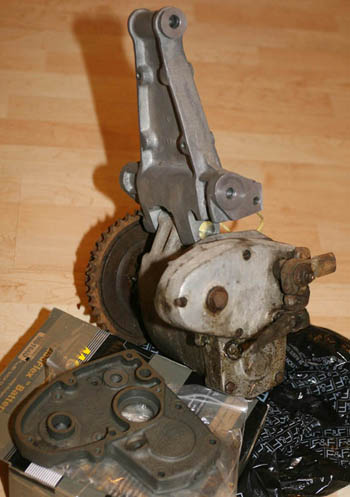
Another view of gearbox as well as Vincent F106/1 Rear Frame Upright Casting. It still has the remnants of a chopped gear lever attached. This is good enough to have a new end welded to it, then to be reshaped to the correct profile for Grey Flash rearset linkage.
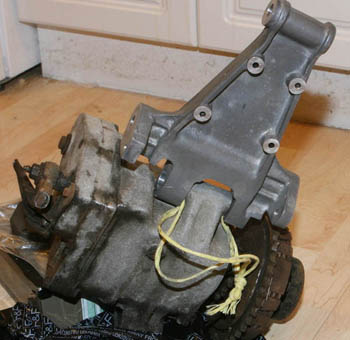
From this front view you can see the webbed top central gearbox lug.
Gearbox is complete and had been previously fitted in a grasstrack bike.
Albion Clutch,
As an added bonus, the gearbox came complete with original Albion clutch and gearbox sprocket in reasonable condition. The clutch looks to be of the correct overall type as originally fitted to Vincent Grey Flash’s and its outer drum seems to have been lightened at some point – as per many racing clutch baskets.I know that Albion listed both 4 plate and 5 plate variety of this clutch and this looks to be the 4 plate version. It would not surprise me to find out the Grey Flash was originally fitted with a 5 plate version – but I am not going to worry too much about this. As a starting point this will be fine and if it proves a problem in use then I would not think it would be too difficult to find the larger outer and inner clutch bodies (I seem to remember my Works Rep RE Trials Bullet was fitted with a similar clutch). Besides, that is a long way down the line yet!
The other option I know was available on this clutch was either a 3 spring or 6 spring version. I am pleased to see that this is the more powerful six spring version (identifiable by the 3 dimples on the outer clutch cap which are used to retain the additional 3 springs in place. This is good news, as I am sure this would have been the version fitted to a Grey Flash.
And finally of course, knowing that this gearbox/clutch combination came out of a working bike as a complete unit, it hopefully means it should have all the little bits like clutch pushrods, retaining nuts etc and will all fit together easily – which as we all know, can be the most time consuming part of building bikes when the parts have all come from different sources.
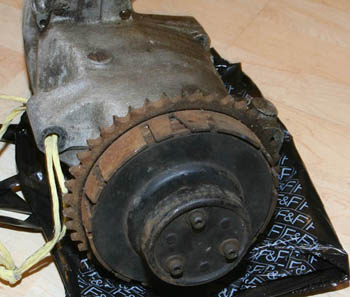
As an added bonus, the gearbox also came with its original clutch still fitted, including lightening slots in cage.
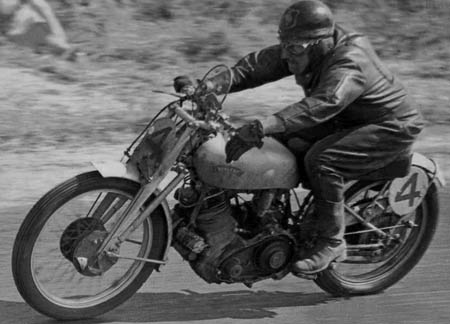
Nice period shot of original Grey Flash, but with open chaincase showing similar Albion clutch fitted
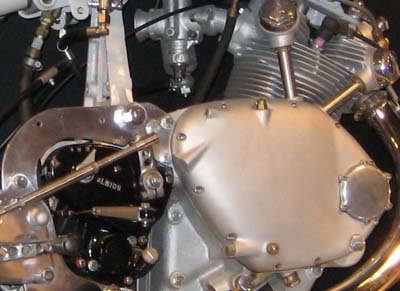
This Grey Flash is a beautfiul restoration and on the face of it is fully genuine - including a magnesium gearbox? . . . but look closely and you will see that the gearbox filler plug is in front of the layshaft boss - meaning it is a 'Kickstart' (Type 16) gearbox, not the full racing Type 5. I suspect this tyype was not originally made in magnesium - therefore this is likely to be just black painted aluminium!
Magnesium Albion Gearbox?
Albion also offered a magnesium option for their Model H racing gearbox, although how many of these were made I have no idea - with such a small production gearbox it could not have been many!
I believe at least one Grey Flash was fitted with this magnesium spec gearbox, maybe one of the Works ones used at the 1950 TT? Certainly, I have seen a number of restored Vincent Grey Flash bikes that now appear to have the magnesium gearbox (or at least the outer cover) fitted. However, it is often difficult from the photo of a restored bike to tell if these are genuine bikes, or just very good replica's.
Even more confusing - I have seen that a few of these restorations have the Albion gearbox painted black indicating they are magnesium - but it is difficult to tell if this is to protect them or just to make them look like magnesium (the finish would originally have been ‘chromated’, a chemical process which gives the surface a black finish to protect the magnesium from corrosion, not paint). A good example of this is the adjacent photograph of a beautifully restored Grey Flash, with what initially looks like a black finished magnesium gearbox fitted. However, I notice the filler plug on this gearbox appears in front of the layshaft lug – not behind it. This is a giveaway that it is actually the Type 16 gearbox, with provision for a kickstarter and I think it is unlikely this type of gearbox was ever offered in magnesium.
Incidentally, if you look closely at the same photograph, you will see the layshaft boss itself sticks out further than the cover of the Type 5 racing gearbox – again, confirming it originally would have had a kickstart fitted. Having done a little bit of investigation to find this out (and having confirmed it by checking an Albion spare parts list), I can see that quite a few of the photos of restored Grey Flash's with proper Albion gearbox's actually have this type of gearbox with the kickstarter boss blanked off. This does not necessarily mean they are not genuine - as a few Grey Flash's were fitted with the 'kickstart' gearbox, but it does seem to indicate they are more likely to be later restorations, using a gearbox as close as they could get to the pure racing type 'box.
I have also seen one photograph of a genuine Albion magnesium gearbox shell where the lower gearbox adjusting lug is different to the standard aluminium shell (the type I have) – in that the lug extends to the full width of the gearbox shell and has extra webbing – which I assume is for strength. Obviously, it would be nice to get hold of a genuine magnesium main shell - but on reflection not very practical, as old magnesium tends to get a bit fragile and eventually I would like to get this bike to a point where i could use it in a couple of competitive events.
What I would much rather get hold of is a magnesium version of the oval shaped outer gearbox cover - particularly as my alloy jobbie is damaged and will need repair anyway. Also I notice mine is lacking the 'Albion' writing and gear indicator numerals, which although not unusual, i would prefer. If anyone has one surplus - please drop me an email!
Magnesium Cover Comes My Way
So in my own case, I was more than happy to have found an aluminium version – just finding any kind of Albion Model H gearbox is enough, but as it happens - about 6 months ago, even before I had found the main gearbox, an old Norton friend and customer in Australia told me that some years ago he had one these rare magnesium Albion covers which he had sold to another Norton enthusiast, who was now a current customer of mine – small world! On contacting the customer he was able to confirm he still had the cover and sent me photographs. Although it had the standard corrosion that all old magnesium seems to pick up, it was indeed the genuine article – and even better was ‘New Old Stock’, looking like it had never been fitted. Although not cheap (I did not expect it would be for such a rare item!) a deal was soon done and I was well chuffed when it arrived safely a couple of weeks later in the UK.
When I did my last batch of chromating of Norton timing covers a couple of months ago, I also included this cover, having first fine blasted it to remove the corrosion and original chromating – it now looks again like it has just come out of the factory! When eventually I come to strip and rebuild the gearbox I am hoping to replace the original alloy cover with this magnesium version, which should look great and save a little bit of weight. Needless to say - If anyone happens to have a similar magnesium outer cover available, I would be interested!
As a final point of interest, you will notice from the photograph that the magnesium gearbox cover has the inscription ‘H TT92’ stamped on it. I assume H is the model number, TT represents a ‘TT spec’ gearbox and not sure what the 92 stands for, but maybe this is the actual gearbox number – just like both Norton and Vincent engines have all their mating castings stamped with the same number. What I would read into this though, is that the stamping ‘TT’ could mean that these magnesium spec gearbox’s were specially made for the Isle of Man TT? Not sure, but that is always the interesting part of acquiring one off and low volume competition parts – trying to work out the background of why and what they were made for
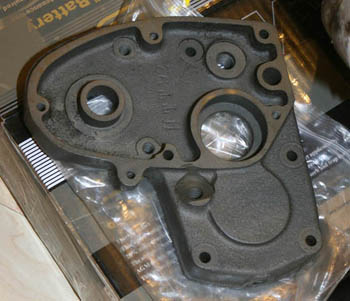
Magnesium inner gearbox cover is New Old Stock and came from Australia (from a RacingVincent customer via another customer - thank you both). Having lightly blasted it to remove corrosion and then re-chromated, it again is looking like it is fresh from the factory - and will look really good fitted to this gearbox
. . . And Then There Is The Frame Tie
It would be nice to say that, having found such a rare item as this particular gearbox, all the hard work would have been done and I could now start looking towards some of the other parts of the bike where I have parts missing. . . but sorry to say we have not left the gearbox area yet!
Because when Vincent’s decided to use the Albion gearbox for their Grey Flash model, that presented them with another problem – the gearbox mounts on an Albion box are completely different to the Comet/Meteor models Burman box. Therefore they had no option but to make up a new version of their F106 Frame Tie (not surprisingly giving it the nomenclature F106/1) which had the lower part of that casting changed to suit the Albion gearbox.
As a bit of history, most Vincent enthusiasts will probably know that post-war the Series B Vincent twin was actually designed before the single, the first prototype being made in 1946 if memory serves me right. This used the engine as a stressed frame member, with the top of the front cylinder head connecting to the front of the Upper Frame Member (effectively the ‘backbone’ of the chassis) and the top of the rear cylinder connecting to rear of the same UFM (but with the rear cylinder mount being adjusted so slight movement was allowable as the engine expanded and contracted as it got warm). When later on (‘48/49?) Phil Vincent decided to resurrect the pre-war single cylinder Meteor/Comet model he wanted as many of the parts of the twin as possible to be interchangeable to the single, to cut down tooling and setup costs. Therefore, the same basic chassis and engine configuration was used, but for the rear frame mount, rather than the (omitted) second cylinder, a high quality aluminium casting was used to act as a chassis member, connecting the gearbox top mount to the rear of the UFM. Every part on a Vincent gets a part number preceded by a character, so this part got the number F106, with ‘F’ relating to frame. In Vincent lore, if they then had to make a variation of that part at a later stage, they gave it a ‘/’ followed by an ascending numeral. Therefore, as the Grey Flash was the first (and only) variation on the standard roadgoing F106 it was numbered F106/1. Not surprisingly, this is another item you are not likely to find at your standard Sunday afternoon autojumble! Again, I can say that in 30 years of keeping my eyes peeled for one of these elusive items, I have not even seen a sniff of one. However, I would also caveat this statement, to say that they are not the easiest item to identify from their standard F106 relation, it only being the mounting points that are visually different – and not many people (myself included!) would immediately spot the difference.
Moving from Comet to Grey Flash Frame Tie
As it happened, in my collection of spare Comet parts (which was to form the basis of my Grey Flash rep build), I do have a standard ‘Comet’ model F106 frame member. As mentioned earlier in the article, this has always been a ‘back burner’ project for me, not really sure I would ever get enough parts together to start the build – but in the back of my mind I had figured that having this standard frame member gave me the option of either using the spare Comet gearbox I also have (if I never found a suitable Albion box), or if I was lucky to find one, I could possibly chop the bottom of this frame tie and do some pretty serious welding surgery to build in the correct Albion mounting lug.
Luckily, I did not have to go this route because about 6 months a friend sent me a link to E-Bay where he had seen someone advertising a F106/1 Upright Frame member. Unfortunately, when the friend had emailed me I was away for a couple of days and by the time I had opened the email the listing had ended – bugger and bo**ocks!
I emailed the seller in resigned desperation to let him know that if the buyer drops out I would be happy to step in, but was over the moon to get an email back to say they were replica’s he has had made to an original pattern and he has another one available – hurrah!
A deal was quickly done, the seller very fairly accepting the same price as the previous one had sold for and shortly a stout cardbox package arrived in the post (I love stout cardboard packages . . . I am sure the growth of internet shopping in the last 10 years has completely resurrected the role of the hallway table/bench in thousands of people’s homes – to stack that day’s delivered online purchases!). Once opened I was really pleased to find the frame tie looked to be of excellent quality and was fully machined ready to fit. It even had the small F106/1 part number cast into it, designating it was the Grey Flash version. As you can see from the accompanying comparison photograph of the casting alongside the standard type fitted to my Comet – the mount points are very different. When a few months later I acquired the Albion gearbox, I immediately test fitted the F106/1 and was pleased to find the fit looked good.
I know that when I come to fit the parts for real, I will also need to make up steel distance sleeves that slides through each side of the F106/1 lug - F110 and F117 (they were probably F110/1 and F117/1 but the spare parts catalog do not show them), but this can wait until the build is in progress – I have a suitable length of 1” diameter titanium bar which should be ideal for this purpose, as a further weight saving exercise.
The last part of this Grey Flash gearbox parts collection is another casting – called the Gearbox Link, part number F102 on the Comet/Meteor, but different again on the Grey Flash (Quelle surprise!) – and called F102/1. This small casting’s purpose is to hold the gearbox lower mounting lug in the correct position away from the engine crankcase on the timing side . . . and because of its position it is difficult to see and therefore not a commonly identifiable part. As with the other Grey Flash parts – I am not even sure what one looks like . . . but in this case I have not found one yet . . . so anyone with one of these surplus in their possession – I would be interested to hear. In the meantime, I have a spare standard Comet F102, and do not think it would be too difficult to perform surgery on this item – but first I would like to confirm what the difference is, which can wait until I am ready to start building. Incidentally, I did find on Youtube recently a photo slide show of someone advertising a genuine Grey Flash for sale – and this slide show had a number of interesting photographs, including a shot of this F102/1 item. I hope they don’t mind me including a copy of that photo here for reference.
Oh, while I think about it, there is of course one further part that is needed to complete all the different Grey Flash gearbox parts collection – that being the big alloy G50/2 Gearbox Pivot Plate. This is the big easily identifiable alloy plate that surrounds the gearbox on all postwar Vinnie singles, and again, acts as a frame member – it also serving purpose of acting as the timing side swinging arm mount. The standard Comet/Meteor version is G50/1, but is a very different shape to the G50/2 version of the Grey Flash, to match the different overall shape between Burman and Albion boxes. Not surprisingly, I do not have one of these either, but am not particularly worried – when I stripped my own comet down recently I took a template of all the hole positions of the G50/1 so I could get lasercut copies made if needed in the future. However, I knew that – using reference photos of the Grey Flash version I have to give the particular shape of the G50/2, in conjunction with the template holes of the G50/1, it should not be too difficult to make up a lasercut version of the G50/2 myself.
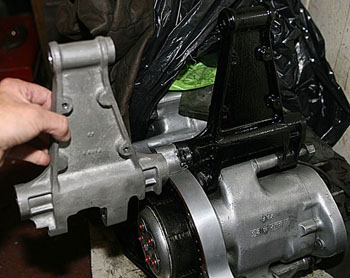
Grey Flash Frame Tie (F106/1) on left and Comet Frame Tie (F106) shown here in side by side comparson. You can clearly see the lug on the bottom right side is in a different location
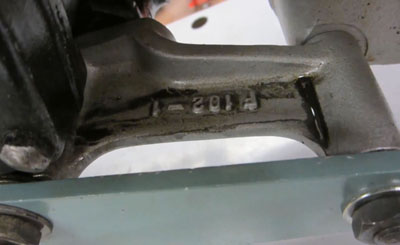
This is a genuine Grey Flash F102-1 lower Gearbox Link. . . although not mine, as I havent found one yet! If I cannot find one I will try and modify a standard F102 item which I do have
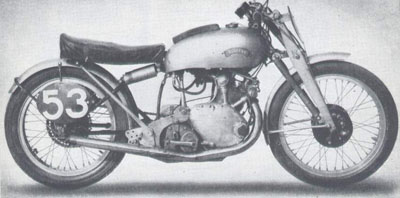
Period photograph of hte Works Vincent Grey Flash in 1950, notice this bike is fitted with what looks to be a magnesium BAR gearbox. If you click on the photo to see the enlargement you might just make out that the frame upright on this bike looks to be fabricated from tubing
So with that, I am now feeling I have made really positive inroads into collecting enough parts to make building a Grey Flash Rep a serious proposition. I will keep collecting parts as they come available, but the biggest issue now is what to do first after finishing the Comet – go back to the ’37 Road Inter which I started 4 years ago, the 600 sidecar Manx (which has been a dream build for me for some time), or the latest fad – this Grey Flash build . . . l am lucky to have such a choice!
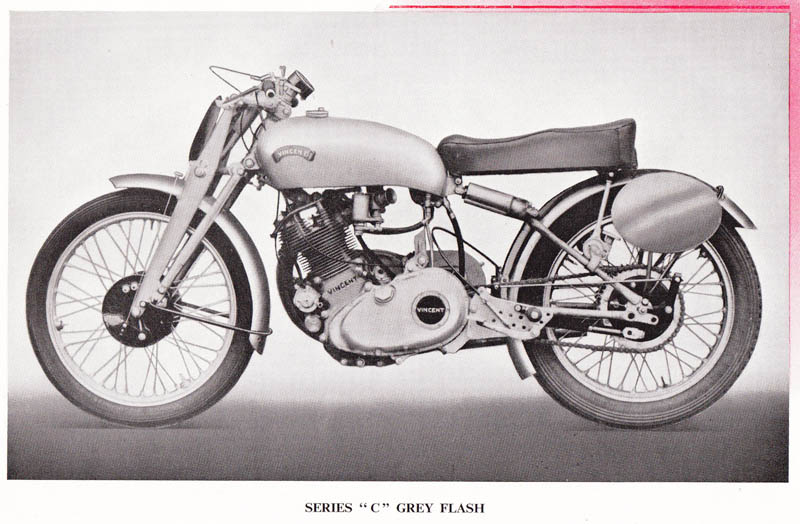
This is the Vincent (1950) Catalog picture of the Grey Flash - as far as I know the only factory picture of a Grey Flash produced.
Incidentally, I scanned this picture from a mint condition original catalog I have - a cherished Xmas gift from Titch Allen 20 years ago
Period Vincent Grey Flash Photos
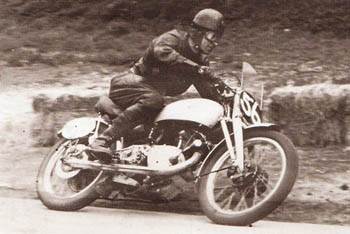
This photo came from a friend and is previously unpublished, I am told the rider is johnny Hodgkin and the venue is Cadwell - not sure on year though
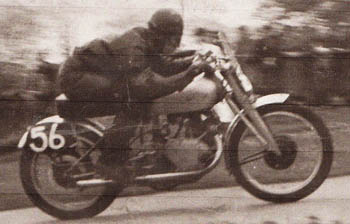
Another photo of Johnny Hodgkins - I assume from the same meeting. Very similar spec to Works bike, but note straight exhaust pipe and seat supports are standard vincent dampers to RFM
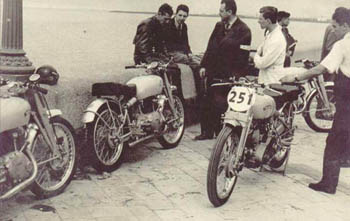
The most Grey Flash's I have seen together at one time! I count 4 bikes here, so assume it is at the TT or similar - all look like standard (non Works) bikes
Vincent Grey Flash Background
My earliest memory of a genuine Grey Flash was not actually of seeing one being raced – but with my father walking through the grass car park of a late 1960’s Mallory Park for one of the very first VMCC Racing events, and seeing a Grey Flash complete with lights and in road trim. It was only years later I discovered that a few Flash’s were kitted out in this trim, and I assume it is these that were fitted with the Type 16 (kickstart type) Albion gearbox.
Anyway, on reflection, that first glimpse of a Grey Flash in the flesh did have a lasting impact on me, because ever since I can remember afterwards I had wanted to build one – and as my father had a number of spare parts for his Comet, including a complete spare engine and forks etc in the garage, I remember continually pestering him about it as a young teenager. As time moved on and I was actually allowed to start building something myself, it was not a Vincent but a rigid framed 16H Norton that my father let me build in our garden shed – using up parts bought in the early 1970’s. That bike provided my first ever ride on a proper bike ( I think at the age of 15) – a very short trip down our driveway with no silencer fitted and the brakes only vaguely working, a scary trip which ended with the garage door finally slowing my progress! (and as I remember, the threat by my next door neighbours to tell my parents when they got home!). I suppose that ruse on my father’s part worked well enough though, because I went on to show far more interest in building up Norton’s for racing and my father managed to keep hold of his Vincent spares for a bit longer!
A lot of water has gone under the bridge since then, and as you know from my other articles and this website . . . a couple of other Vincent’s beside – but I have never been able to get rid of that desire to one day put a Grey Flash rep together, so while working on many other bikes over the years, I have also been quietly keeping an eye out for suitable parts ever since.
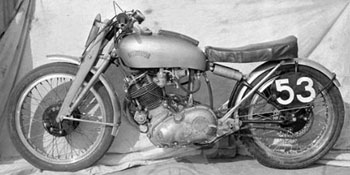
Another period shot which again shows teh Works Vincent Grey Flash. As well as the previously mentioned BAR gearbox - notice this is one of the first instances of a seat using a regular (sprung) subrame - rather than using the standard 'semi sprung' dampers running to RFM - probably better for racing. Note also paintwork looking more silver than grey
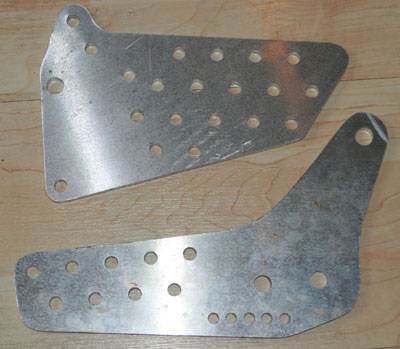
These are not newly acquired - but are a set of plates I had lasercut at the same time as I had my Black lightning plates made - they are cut from templates I made 20 years ago - taken from original Black Lightning hanger plates (from Ted Davis's Lightning). These will be fitted to the Grey Flash replica
Final update - the search for parts continues . . .
Update 14/2/15: Since starting to write this article a few weeks ago, I have been fortunate and a few other parts have also 'fallen into my lap' so to speak. Luckiest 'find' was to acquire a pair of original magnesium racing front brakeplates shown below. They have a couple of small chips which may be difficult to repair, but otherwise look good and straigth and include the original screw on scoops.
I have also acquired a very straight petrol tank - although I was thinking about using a fibreglass copy I have over an alloy tank that covers one side, allowing me to use electronic ignition/battery on the other side . . . no need to make a final decision on that at the moment - I purchased the tank because good ones very rarely come up and I wanted the choice.
Still looking for an RFM if anyone has one and front finned brake drums, rear racing brakeplate, sprocket carrier or any interesting original Grey Flash parts if anyone has any - although my Vinnie 'savings pot' is now good and empty - so may need to let funds build up again before going any further!
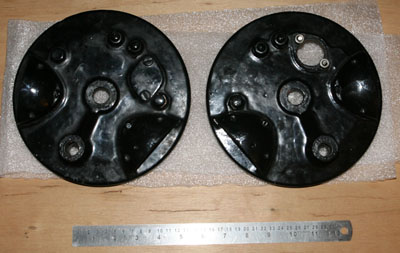
Recent and very lucky find - original Lightning/Grey Flash magnesium front brake plates with cooling scoops. These look in pretty good condition, other than a couple of chips around the external dust excluding rings - although I suspect this will be a difficult fix
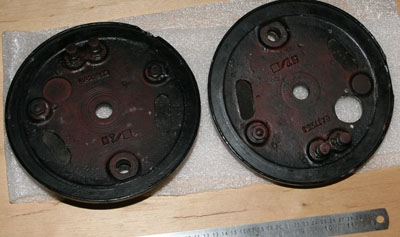
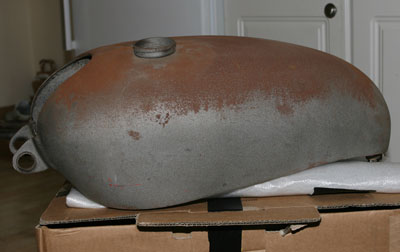
Recent (and very expensive!) acquisition is a nice and undented early Vincent//HRD petrol tank. I notice there is a marker pen underneath pointing to a potential leak - but as this tank has the early (small) carb cutaway, it will need to have some surgery to accomodate the big 32mm Amal RN I am planning to use anyway
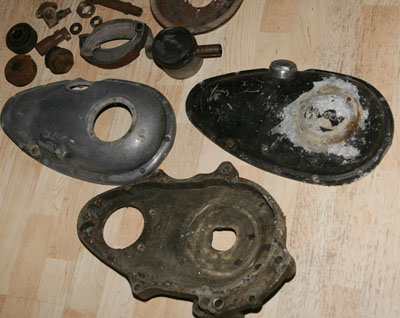
And finally . . . the latest finds - Primary chaincase - good inner below and two outers above. Some Grey Flash reps dont bother with the outer cover, but at least one of these will be blasted and have cooling holes drilled around the top right of the cover - probably the black one, which is quite corroded but should clean up. Interesting pile of bits in top left corner include old Specalloid high compression piston, and what I hope is a slightly rusty but usable MkII cam
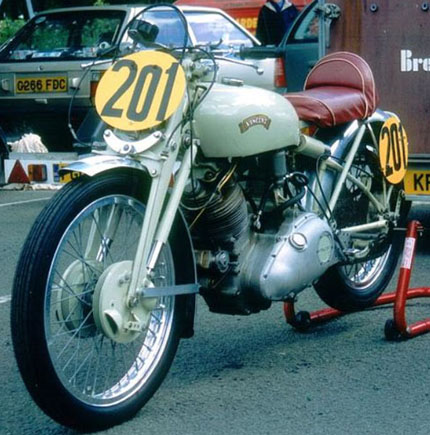
And just as a reminder, this is a photo of another Grey Flash Rep that came up for sale last year at Bonhams. I had met the previous owner a couple of times at race demos over the years and this was a very nice bike - looking very much like the genuine article . . . hoping mine might eventually look similar
